
Photo by Chris Beytes, GrowerTalks Magazine
Frank and Pamela Arnosky, along with daughter Hannah Rose, center, and employee Jorge Cruz Ramirez, bundle and wrap bouquets for sale under their company name, Texas Specialty Cut Flowers.
If you have ever wondered where the bouquets of cut flowers in grocery stores come from, you might be correct if you guessed South America or California.
Unless you live in Central Texas, that is.
In an industry dominated by imported flowers, Capital Farm Credit customers Frank and Pamela Arnosky have built a successful business growing flowers on their family farm near Blanco, Texas, for local customers who like their cut flowers fresh.
Year-round, the couple grows 60 different varieties of flowers in fields and greenhouses at Arnosky Family Farms, and their handmade bouquets are sold in more than 40 retail outlets — less than 48 hours after being picked.
“We are the Texas premier producer in the cut-flower market,” Pamela says. “We’re the biggest and the best in our state. This is our profession. There’s been nothing haphazard in what we do, from growing our flowers to marketing them.”
The only thing even a bit haphazard about their flower business is its unplanned rapid growth.
$1,000 Down and a New Chainsaw
The story of Arnosky Family Farms began nearly 30 years ago, when Frank and Pamela — Texas A&M University college sweethearts who met at a polka dance — were young and yearning to start a farm in the Texas Hill Country. Frank, a trained horticulturist, wanted to farm full time. Pamela, an adventurer with a degree in plant geography, shared his goal.
When 12 acres of owner-financed, rich bottomland soil came up for sale on the Hays–Blanco County line, they jumped at it. With $1,000 down and a brand new chainsaw, the couple started their farm, clearing junipers to build a house and their first greenhouse.
Over the next two years, they built three greenhouses, where they raised high-quality bedding plants for independent garden centers in Austin, College Station and Houston, Texas. As their family expanded, Frank managed the greenhouse operation while Pamela focused on their four children. But wanting to do more, she suggested planting a quarter-acre of snapdragons in front of the house to sell in bunches.
Customer response to the fresh flowers was enthusiastic. Buoyed by the snapdragon sales, the Arnoskys branched out to growing zinnias, larkspur, sunflowers and other annuals. With a new direction for the family business, Texas Specialty Cut Flowers was established.

Photo by Kanokwalee Pusitanun
The Arnoskys’ Blue Barn Farm Market looks out at a sea of larkspur in springtime.
Reaching a Niche Market
The Arnoskys’ first wholesale flower customer was Whole Foods Market in Austin. But their big break in the flower business came in 1994, when they made a cold call to Central Market, a new high-end grocery store that the H-E-B Grocery Co. had just opened in Austin.
“They loved our fresh Texas flowers,” Pamela says. “Every time H-E-B opened another Central Market, we stepped up production to meet the increased demand for our flowers. So we literally grew our business as Central Market grew theirs.”
The connection also formed at a time when farm-to-market networks were gaining momentum.
“Our partnership with the first Central Market showed that local flowers could be grown and sold at the grocery store level,” Frank says. “It really opened up the doors to local flower growers nationwide.”
In 2003, to keep up with the increasing demand for their flowers, the Arnoskys purchased 100 acres at a corner spot just two miles from their existing farm. To finance the property, they turned to Capital Farm Credit.
“Back then, we were a first-generation farm and had no capital to buy that land,” Pamela remembers. “Our local bank wasn’t in a position to help us, whereas Capital Farm Credit could. They took a chance and helped us start another farm.”
Jim Price, their first Capital loan officer, still remembers making the loan.
“They showed me they had the expertise and knowledge to do what they wanted to do,” Price recalls. “It tickled me that we were able to provide the financing so they could accomplish their goals. They’ve done the rest to be successful.”
“It tickled me that we were able to provide the financing so they could accomplish their goals. They’ve done the rest to be successful.”
Jim Price, Capital Farm Credit
An Old-Fashioned Barn Raising
On the new land, they built greenhouses and put in flower fields. Five years later, friends and family turned out for an old-fashioned barn raising on the site.
“Through the years, we’ve provided fresh flowers for local nonprofit events and fundraisers,” Pamela says. “So when we put the word out in 2008 that we needed help with raising a barn, more than 200 people showed up to build it.”
The community project built what’s now called the Blue Barn Farm Market, a roadside stop where customers can buy flowers, bedding plants, fresh eggs and locally made goat cheeses.
Today at the corner location, the Arnoskys grow cut flowers on 40 acres and inside 29 greenhouses. Four greenhouses are propane-heated for winter production, and the rest are gigantic cold frames that convert into shaded growing houses for hot days.
As soon as they’re cut, flowers go straight into water-filled buckets. Next, they are hand-bunched, wrapped in cellophane sleeves and put into coolers for delivery on trucks to three Central Market stores and 40 H-E-B Blooms shops. In addition, Arnosky flowers retail at the Austin Flower Co. and are sold direct to do-it-yourself brides for weddings.
Altogether, wholesaling generates approximately 84 percent of the farm’s revenue, and the rest comes from sales at the Blue Barn.
On the flip side, that much production requires a lot of physical work. Year-round, the couple employs five full-time farmhands and four part-timers. They also hire seasonal guest workers through the federal H-2A Temporary Agricultural Workers program.
“Farmers can’t farm without labor, and we use only legal labor,” Pamela says. “On our farm, every H-2A position supports two or more full- or part-time positions, such as drivers, for U.S. workers. So the program generates jobs.”
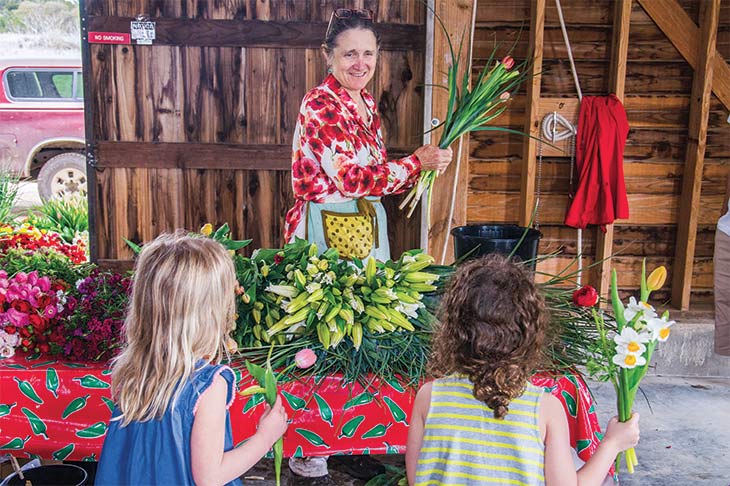
Photo by Sheryl Smith-Rodgers
Pamela Arnosky answers questions from young flower shoppers.
Their Own Farmers Market
At a table piled high with fresh-cut flowers, Pamela Arnosky arranges white lilies, red ranunculus and pink tulips into cellophane-wrapped bundles. While she works, local residents and passing tourists step in and out of the Blue Barn Farm Market, an open-air barn painted royal blue and fashioned after a German society hall. They’ve come to buy flower bouquets, browse green lettuce in plastic bins, look over bedding plants in a nearby greenhouse, and maybe stroll through a flower field.
“We want people to think of the Blue Barn as their rural community center, and also as a destination,” Pamela says.
Toward those goals, the Arnoskys host annual community potlucks and old-fashioned dances at the Blue Barn. They invite visitors to walk the flower fields and chat with Pamela when she’s there on Saturday mornings. They even hosted participants in the American Grown Field to Vase Dinner Tour at a supper in the Blue Barn two years ago.
Most recently, they conducted a workshop on how to grow cut flowers. Profits from the classes will go toward expanding the barn.
“We plan to put in a pavilion, kitchen, farm store, meeting areas and restrooms,” Pamela says. “We want the Blue Barn Farm Market to be a lively gathering place that’s both innovative and educational.”
Cornering the Marigold Market
The journey to success hasn’t been easy. Tornadoes, ice storms, floods and grasshoppers have clobbered the farm from time to time. Yet, through thick and thin, Pamela homeschooled their children — Derrick, Hannah Rose, Janos and Elena — and the farm provided them with after-school jobs and financed their college educations. Although none of them have returned to the family business, their parents understand.
“All of our children are outstanding in their fields — they just aren’t our fields!” Pamela quips.
Never ones to wring their hands, Frank and Pamela are always on the lookout for new opportunities. One came a few years ago when Pamela recognized a growing market for yellow, gold and orange marigolds among South Asians and Latin Americans. So she and Frank upped production of the annual flower, which is traditionally used for decoration at Dia de los Muertos (Day of the Dead) celebrations.
“We are possibly the largest marigold grower in the United States,” Pamela says. “For Dia de los Muertos alone, we grow 30,000 plants. For 28 weeks from March to September, we put out 6,000 plants a week. Then we grow them in greenhouses until Thanksgiving to extend their season. We produce close to 200,000 marigold plants a year.”
Through the years, Frank and Pamela have worked hard to promote locally grown flowers. He is a past president of the Association of Specialty Cut Flower Growers and currently serves on the American Grown Flowers advisory council. The two are co-authors of “Local Color: Growing Specialty Cut Flowers,” a collection of regular columns they wrote for Growing for Market magazine.
“As an industry, we’re up against imported flowers grown mostly in Columbia and Ecuador, where the climate’s better and costs are cheaper,” Frank says. “We want to raise awareness that consumers have a choice to buy American-grown flowers, which last longer and support local farms. All our bouquets have the certified American Grown logo.”
Expanding North and West
As if they didn’t have enough to do, the Arnoskys branched out to Minnesota in 2013, buying 87 acres near Lake Superior where they planted 11 acres in peonies, a perennial that tolerates sub-zero temperatures. Their Superior Peonies farm will go online in 2019.
“When temperatures get too hot at our Central Texas farm, we’ll harvest peonies in Minnesota,” Pamela explains.
From the start, risky ventures have never intimidated the Arnoskys. So when Frank proposed another one in December 2016, Pamela didn’t flinch.
“Are you brave enough to sell everything here and grow peonies in West Texas?” he asked while they were seeding spring transplants. “Yes,” she shot back.
That night, Frank surfed real estate on the Internet.
“Look,” he exclaimed to his wife. “Remember that land we’ve loved near Fort Davis? It’s for sale.”
The next weekend, they made the six-hour drive to see 58 acres of red dirt and high desert plains, located at the foot of Blue Mountain.
“We’d had our eye on that land for years,” Pamela says. “We used to pass by it when we’d camp out with our kids in Fort Davis every summer and fall.”
A Place for Peonies
Right away, they made an offer on the Fort Davis land.

Photo by Whitney Devin
Frank and Pamela Arnosky in a field of marigolds on their Blanco, Texas, farm. They are one of the largest marigold growers in the U.S. In May, the Arnoskys contributed flowers for the First Lady’s Luncheon in Washington, D.C., and Pamela helped design the American-grown floral arrangements for the event.
“We assumed that we’d have to sell part of our farm in order to finance it,” Pamela says. “Then it occurred to us that, since we’d paid down our note significantly and the equity in our land had increased, Capital Farm Credit might finance the new purchase instead.”
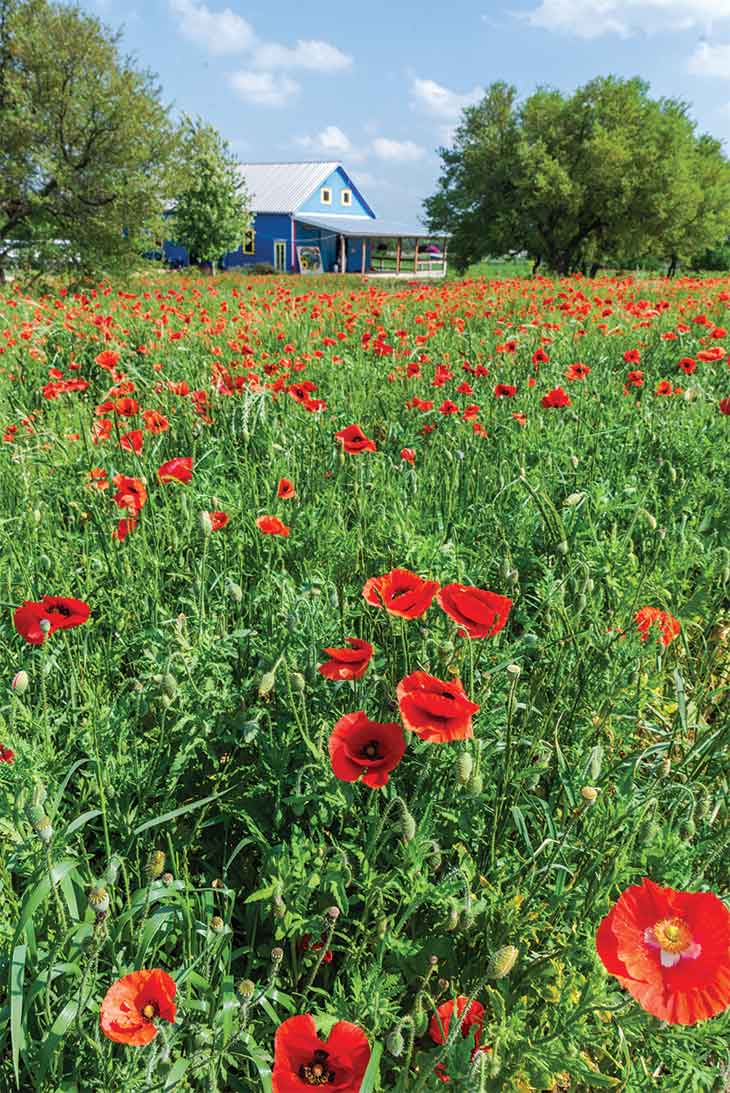
Photo by Kanokwalee Pusitanun
Red poppies light up a field beside the Blue Barn, where customers can purchase fresh flowers, bedding plants, eggs and local goat cheeses.
The Arnoskys contacted Chase Lore with the Lockhart branch office, and she made it possible for them to roll their existing note into a new one. As soon as the deal closed in June 2017, the Arnoskys headed to Fort Davis. That weekend, they camped and plotted out peony fields.
“Pamela later e-mailed me some selfie photos from their land,” Lore says. “One of the best parts of my job is helping people like the Arnoskys achieve their goals and dreams. They’ve earned this opportunity, and we wanted to be a part of their new location.”
Like their Minnesota venture, the Fort Davis farm will take several years to get established.
“We laughingly call it our ‘active retirement plan,’” Pamela says. “Peonies bloom over a three-week interval, and that’s it. We’ll spend the rest of the year in Fort Davis cultivating them.”
“Our West Texas farm wouldn’t be possible without Capital Farm Credit,” Frank adds. “They allowed us to use our farming success to build our business, and we couldn’t be more grateful.”
For more information, visit texascolor.com.
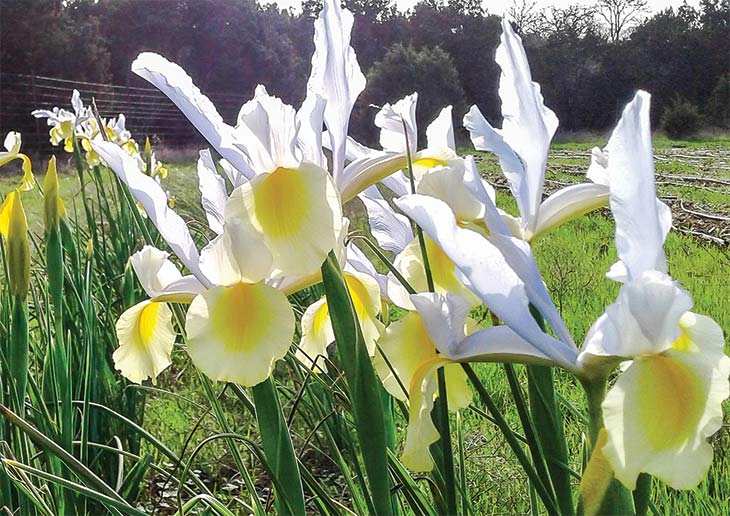
Photo by Arnosky Family Farms
Spring
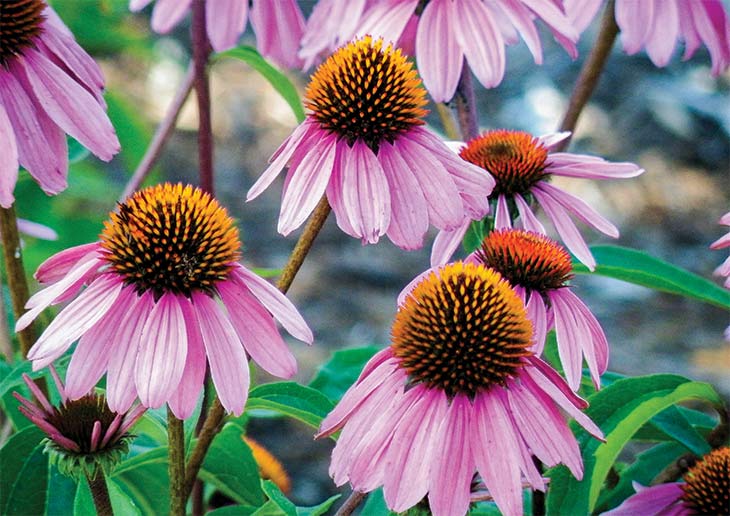
Photo by Arty Allison/Shutterstock.com
Summer

Photo by Arnosky Family Farms
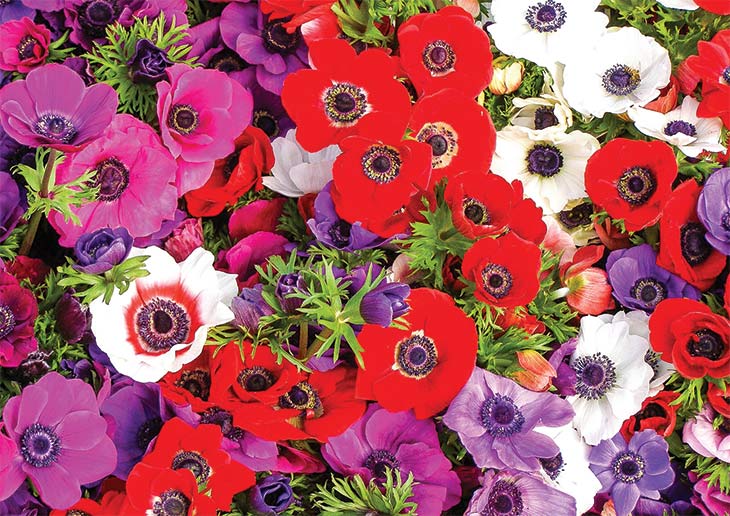
Photo by Arnosky Family Farms
Winter
Flowers by the Season
At Texas Specialty Cut Flowers, fresh flowers are available almost year-round. Following are some of their most popular ones.
Spring
- Dianthus
- Iris
- Larkspur
- Snapdragons
- Texas Wildflowers
- Tulips
Summer
- Black-eyed Susans
- Blue Cornflower
- Echinacea
- Sunflowers
- Texas Bluebells
- Zinnias
Fall
- Cockscomb Celosia
- Fall Mums
- Lilies
- Marigolds
- Plume Celosia
- Salvias
Winter
- Anemones
- Calla Lilies
- Lilies
- Poppies
- Ranunculus
- Sweet Peas